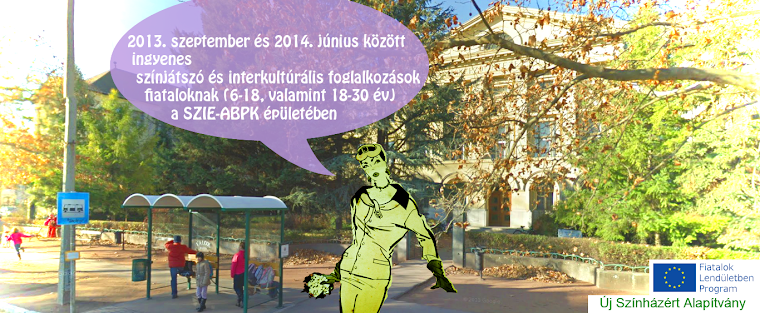After our initial few weeks of ice-breaking games and 'getting to know each other' activities, we decided to give the kids a more substantial task to get their teeth into at the end of the session.
The idea was simple - we divided the class into two groups and myself and Clara would give one of the groups a place (setting) and assign individual characters. They had one minute in which to make up some kind of story involving these characters in this particular place and then they had to perform in front of the rest of the class. They could talk in Hungarian, however, they had to make it very clear WHO they were, and WHERE they were, so that myself or Clara could guess the group we didn't assign.
This worked well - firstly it's good to do something a bit different from games, but also, some of the students who we thought very shy seemed to impress us with this kind of activity - probably because they were able to speak Hungarian, so they could remove the language barrier that may have been restricting them.
After one week of ending with this activity, we decided it's essential to introduce the students to some basic skills, such as HOW TO SHOW SETTING, and CHARACTERISATION.
Our lesson plan naturally evolved to that of 'Characterisation through the body'. After our warm up games (which involve some running games and concentration exercises, depending on the group's needs) we got them to experiment with different types of walks - for example, walking like a business man, a drunk person, an old person, and the idiosyncrasies encompassed by the various types, i.e, gesticulation, body language, speed, rhythm.
We then divided the room into four invisible sections, each one representing either a baby, a teenager, a mother/father, a grandma/grandpa. Students were encouraged to move freely around the room adopting the various characters depending on which section they were in. I like this exercise because it makes use of different levels (baby crawling on the floor), speeds and tempos (a slow old grandma/grandpa) and the way they hold themselves differs completely.
A variation of this is to get everyone to stand at one side of the room. They have one minute to move to the other side of the room, starting as a baby and going through all 'ages', arriving at the other wall as a very old, slow person.
We then ended with the same activity (giving them a setting and characters each) but with emphasis on WHO they were, using the skills they'd acquired from the day's lesson.
Our 'How to show setting' lesson is my favourite. We started with them walking around the room until an appropriate level of focus was attained (!), then they were told to all go to the cinema together. The main thing to look for here was that they all looked in the same direction at the same screen, and sat in rows. Then we could work on other things such as are they eating food? If so what? And what kind of film are they watching? They would then leave the cinema together and go various other places, like a restaurant, a train, a supermarket, the beach. If we didn't think they were portraying it well enough then we could clap our hands and get them to freeze, whilst going and repositioning them until we were happy :)
We also did the 'photograph' exercise. A photographer wants to take a picture in various contexts, so the students have 10 seconds to arrange themselves and then freeze. Examples are a wedding photograph, school photograph, party, etc.
Finally, we did a lesson on 'Facial expressions'. Some of the students are very shy about using their faces so we played with masks - students put on an imaginary mask which gave them a new facial expression. They would then adapt their bodies and movement to fit this face and interact with each other.
We would also do various basic emotions (happy, sad, angry, in love, scared) and stood in a line they had to change their faces as Clara moved her hand past their faces.
I created a game to encourage them to elasticate their faces a bit more. It involved half the room being statues - in a park, or at Heroes Square in Budapest, or in a museum. When I clapped my hands they would become statues with a specific emotion that I would say - 'scared statue', 'ugly statue', 'in love statue', ' brave statue', 'angry statue' etc. The rest of the students would walk around and try to make them move/laugh by pretending to be, for example, Chinese tourists taking pictures and walking around speaking 'Chinese' and talking about/ laughing at the statues. I like this exercise as it incorporates different skills, such as concentration, balance, stillness, facial expression, body language, creativity, focus.. and so on!
We are now in the final week (some groups are doing setting this week, some are doing faces) and next week is half term already!
Autumn workshops will be taking place in clowning and singing/dancing before we go and enjoy a spot of travelling around the beautiful Eastern Europe!

